#informative
Text
Wet Beast Wednesday: spiny softshell turtle
It may be neither Flat Fuck Friday nor Turtle Tuesday, but because this is my series and I can do what I want, I'm talking about a very flat turtle. The spiny softshell turtle (Apalone spinifera) is the most widely distributed and possibly the most common softshell turtle in North America. Its range covers most of the Eastern half of the USA and stretched into Canada and Mexico. There are 6 subspecies separated by geography and hybridization can happen in places where their ranges cross. Hybridization has also been known to happen with the Florida softshell (Apalone ferox). The subspecies are the northern (A. s. spinifera), gulf coast (A. s. aspera), Texas (A. s. emoryi), pallid (A. s. pallida), Guadalupe (A. s. guadalupensis), and black (A. s. atra) spiny softshells.

(Image: a spiny softshell turtle seen from above and to the side. It is a turtle with a wide, flat shell. Its head and one foot are visible. The head is skinny and has an elongated nose. The foot is wide and flat, with webbed toes. The turtle is an olive green with black dots on the skin, yellow stripes on the face, and dark spots on the shell. End ID)
The thing that makes a softshell a softshell is the lack of keratinized scutes on their shells. This makes the shells smooth and leathery. The center of the shell has a layer of solid bone user it, but this does not extend to the edges of the shell, making it less rigid. Softshells are the fragile speedsters of the turtle world. Their shells are a lot lighter and often more streamlined, allowing for faster movement both on land and in water, but they provide less defense. Spiny softshells have spiny projections along the front edge of the carapace (upper shell), with males having more than females. They are some of the largest North American freshwater turtles. Females can reach a carapace length of 54 cm (21 in) and 11 kg (25 lbs) while the smaller males max out at about 25 cm (10 in).
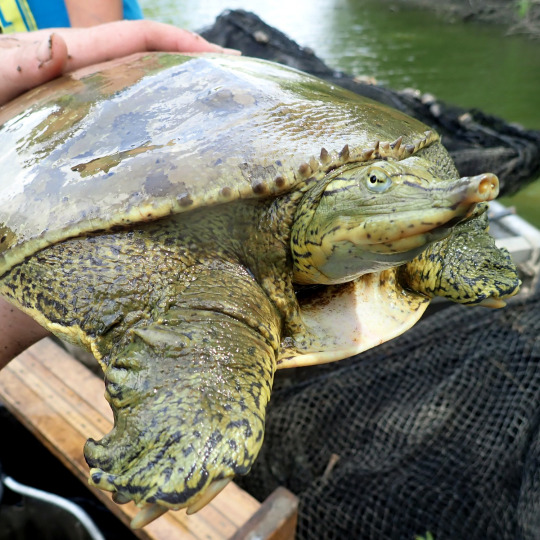
(Image: a spiny softshell being held by a person, seen from the front. The leading edge of the carapace is visible, showing off the small spines. End ID)
Spiny softshells have wide, flat, paddle-like feet with three claws and an elongated nose that acts like a snorkel. The turtles are born a bright olive color with striped faces and dark spots on the shell. Males keep their juvenile coloration for their entire lives while females grow darker ad lose many of their markings. It can be very difficult to tell females of different subspecies apart, while males and juveniles can be distinguished by their markings. Smooth skin and highly vascularized membranes in the cloaca, mouth, and throat allow the turtles to breathe by diffusing dissolved oxygen from the water into their blood.
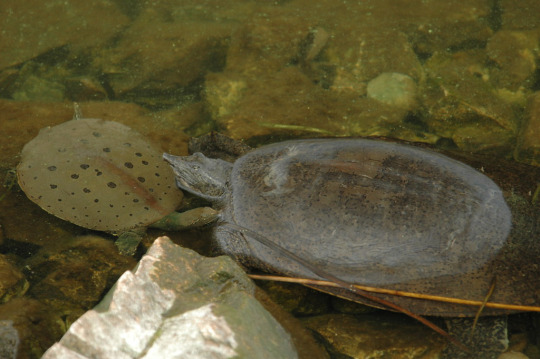
(Image: a male and female spiny softshell facing each other. The male is less than half the size of the female and has an olive colored shell and skin, with dark spots on the shell. The female is a uniform muddy brown color. End ID)
Spiny softshells are generalists able to live in a wide range of habitats. They prefer streams, rivers, and ponds with muddy or sandy bottoms and high visibility, but can live in most freshwater habitats. Softshells are diurnal, spending their days basking and feeding. Being turtles, they are ectothermic, meaning their body temperature matches the surrounding temperature. To warm themselves up, the turtles bask in the sunlight. They can often be found resting on exposed rocks, logs, sandbars, or shorelines. While not particularly social animals, the turtles will bask in groups. When threatened, softshells will attempt to swim away and/or bury themselves. In the right sediment, a softshell can bury itself in under a second. Because their shells are less rigid, softshells have to actively defend themselves when cornered and will bite and scratch. People have to be careful when handling them. They brumate (that's hibernation for reptiles) during winter. While brumating, they bury themselves underwater and slow their metabolism and oxygen requirements. In this state they can fully sustain themselves on oxygen absorbed through their skin or special membranes.
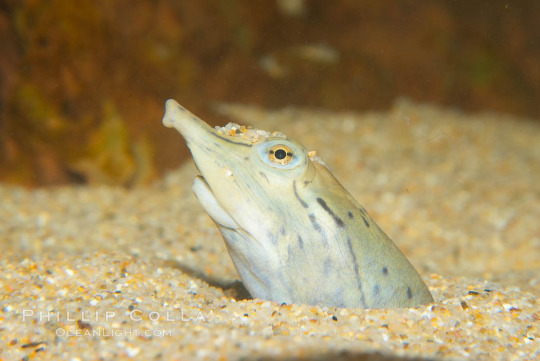
(Image: a spiny softshell turtle buried in its hunting strategy. Only the head is visible above the sand. End ID)
They are primarily carnivores and will eat anything that can fit in their mouths. Aquatic insects, crayfish, worms, amphibians, mussels, snails, fish, and more are on their plate. While capable of fast swimming, they are not pursuit predators. They employ two primary hunting strategies. The first is to bury themselves in the sediment and wait for prey to come by. The second is digging in the sediment to find worms and other animals. Fish have been known to follow digging turtles around to feed on animals unearthed by them.

(Image: a spiny softshell in captivity. It is swimming at the surface of the water in a tank, amongst artificial leaves. End ID)
Spiny softshells mate in spring. Males attempt to woo females by swimming over to them and bumping heads together. The male then sits on top of the female to mate. Unlike most species of turtles, the males do not grab onto the female's shells during mating. Eggs are laid between summer and early fall and will hatch next spring. The female will dig a nest in sandy or gravelly banks and bury the eggs once they have been laid. She provides no further care. Females will typically mate multiple times each year, with each mating having a different nest. The juveniles take 8 to 10 years to reach sexual maturity and they can live up to 50 years in the wild. Many turtles determine sex by the temperature the eggs are incubated in. This is not the case with spiny softshells, who have genetics based sex determination.

(Image: a group of 5 juveniles. The photo focuses on two who are sitting next to each other. One has its front right leg on the shell of the other. They have similar coloration to an adult male. End ID)
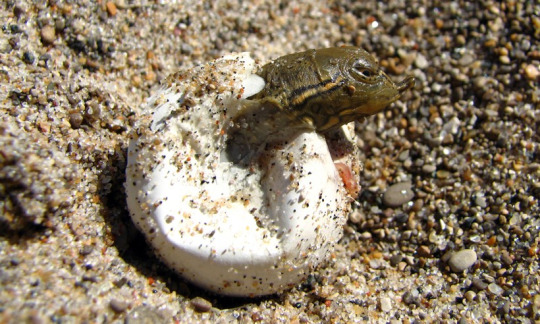
(Image: a newborn emerging from its egg. The egg is round and white, looking like a ping-pong ball. Only the head of the turtle has emerged. End ID)
Most subspecies of spiny softshell are classified as least concern or near threatened by the IUCN, meaning they are not in danger of extinction. The exception is the black spiny softshell, also known as the Cuatro Ciénegas softshell, which is critically endangered. The primary threats to the turtles is habitat loss due to human activity. Adults have no natural predators outside of the Florida and adjacent state populations, which are prey to alligators. Juveniles are eaten by a variety of animals including fish, snakes, raccoons, and herons. People will also eat the adults. Because it can take a whole decade for juveniles to become reproductive, losses in population take a long time to replace. They have been introduced to areas outside of their native range, most notably the western USA. Most of these introductions are due to people releasing pet turtles into the wild.
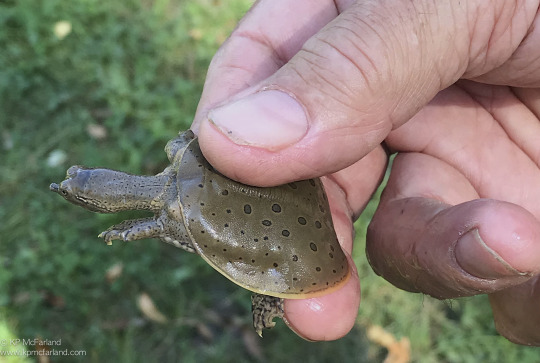
(Image: someone holding a juvenile. The shell is 2-3 times the size of the human's thumb. End ID)
#i typoed it as softhsell more times than I care to admit#wet beast wednesday#turtle#turtles#softshell turtle#soft shell turtle#spiny softshell turtle#reptile#biology#zoology#ecology#animal facts#freshwater ecology#aquatic biology#informative#educational#image described#turtle power#herpetology
53 notes
·
View notes
Text
The Columbine Effect

Repost plus fixed cuz I got termed. Again this is PURELY informative.
—-
The columbine massacre happened April 20th 1999 in Littleton Colorado. This post isn’t about the sh00ting itself but the effects on the world and the years to come.
Since the day over 338,000 kids have experienced gun violence at schools in America. Lead cause of child d3aths? Guns. 1-10 gun d3aths are kids 19 or younger.
The attack caused Americas ‘no tolerance’ policy where any unqualified individual found with weapons on school grounds would face consequences.
The first related incident happened only a few days after the attack, the teens friend Eric Veik had thr3atened to ‘finish the job’ of his friends. After police interrogation he claimed it was simply a joke.
Since 1999 the world has seen a resurgence in school attacks many being copycat crimes. There is 74 known plots 21 played out attacks and the rest being thr3ats or plans. 95% of them were men, 4/5 of them were white. 53% used guns, 18% used explosives and 14% used knifes. 67% obtained the weapons via household. The average age being 17.
2018-23
2022- 46
This is the number of school sh00tings that happened pre pandemic and post. 2022 has had more school sh00tings than the other years after columbine. One of those being the Kerch Polytechnic sh00ting of 2018. Which down to the end was a copycat. Many refer to it as the Columbine 2.0.
In 2022 34 children and adults died and more than 43,000 children were exposed to gunfire.
Sources: crimetraveller, FBI, sandyhook promise
Again if I got anything wrong tell me.
-Vivi
21 notes
·
View notes
Text


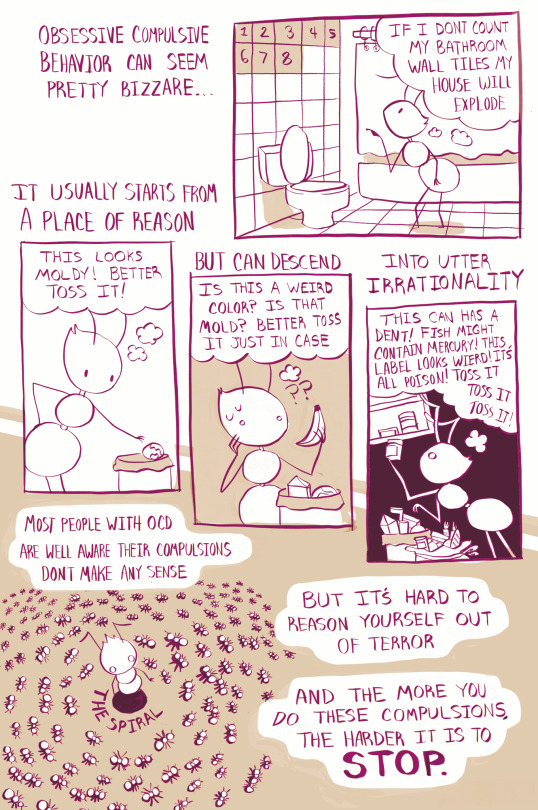



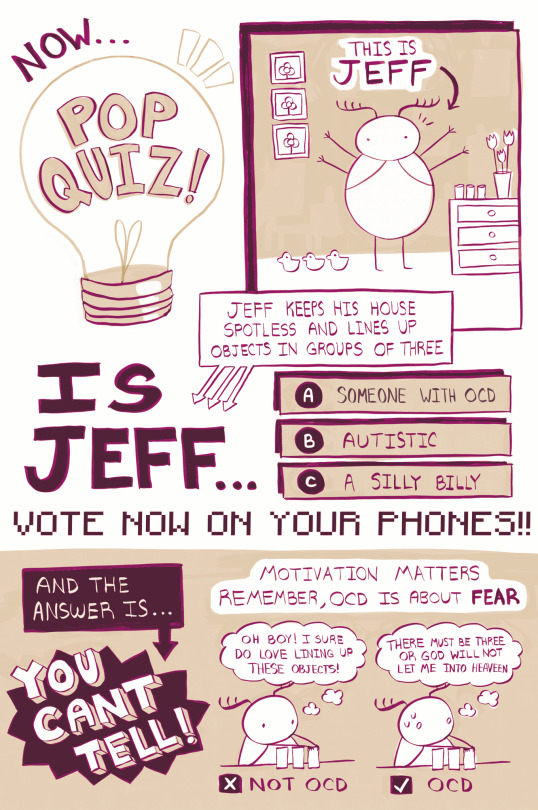


Greetings bugs and worms!
This comic is a little different than what I usually do but I worked real hard on it—Maybe I'll make more infographic stuff in the future this ended up being fun. Hope you learned something new :)
If you are still curious and want to learn more about OCD, you can visit the International OCD Foundation's website. I also recommend this amazing TED ED video "Starving The Monster", which was my first introduction to the disorder and this video by John Green about his own experience with OCD.
The IOCDF's website can also help you find support groups, therapy, and has lots of online guides and resources as well if you or a loved one is struggling with the disorder. It is very comprehensive!
Reblog to teach your followers about OCD
(But also not reblogging doesn't make you evil, silly goose)
#actually ocd#ocd#ocd tag#obsessive compulsive disorder#mental illness#mental health#neurodivergent#infographic#informative#comic#webcomic
48K notes
·
View notes
Text
New Millipede!!! Sphaerobelum turcosa is a newly discovers species of pill millipede that was recently discovered in the Loei province of Thailand. A team of researchers were doing field work in the Phu Pha Lom Forest when they discovered fourteen of these brightly colored millipedes. Due to their stunning coloration these pill millipedes were nicknamed “The Jewel of The Forest”.

Pill millipedes have convergently evolved a body structure similar to that of isopods (aka roly polies) and have comparatively shorter bodies than other species of millipedes, and like roly polies they will roll themselves into a ball when they feel threatened.
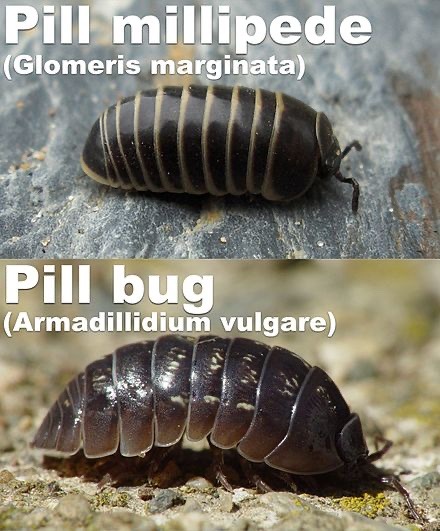
The bright turquoise color of Sphaerobelum turcosa helps warn predators that they are poisonous and not to eat them. This millipede also has tan markings on its exoskeleton that form a mask-like marking that helps to scare off potential predators.
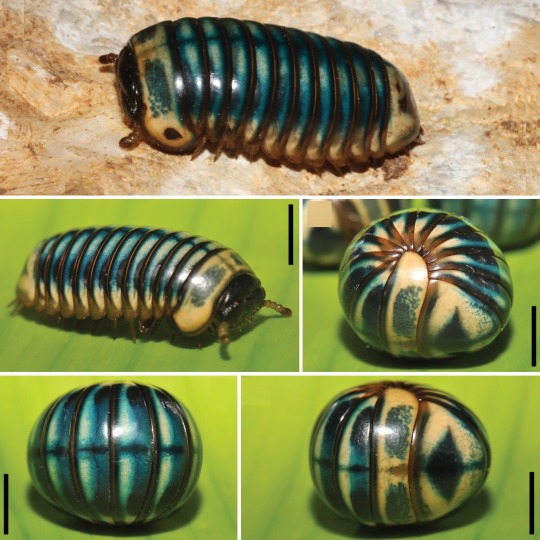
4K notes
·
View notes
Text
A lesson on the greenhouse effect; Dr. Carl Sagan testified before Congress in 1985 on climate change l carlsagandotcom/full vid
#climate change#greenhouse effect#earth#climate crisis#environment#carl sagan#informative#science#planets#greenhouse gases#global warming
1K notes
·
View notes
Text
The Disability Library
I love books, I love literature, and I love this blog, but it's only been recently that I've really been given the option to explore disabled literature, and I hate that. When I was a kid, all I wanted was to be able to read about characters like me, and now as an adult, all I want is to be able to read a book that takes us seriously.
And so, friends, Romans, countrymen, I present, a special disability and chronic illness booklist, compiled by myself and through the contributions of wonderful members from this site!
As always, if there are any at all that you want me to add, please just say. I'm always looking for more!
Edit 20/10/2023: You can now suggest books using the google form at the bottom!
Updated: 31/08/2023
Articles and Chapters
The Drifting Language of Architectural Accessibility in Victor Hugo's Notre-Dame de Paris, Essaka Joshua, 2012
Early Modern Literature and Disability Studies, Allison P. Hobgood, David Houston Wood, 2017
How Do You Develop Whole Object Relations as an Adult?, Elinor Greenburg, 2019
Making Do with What You Don't Have: Disabled Black Motherhood in Octavia E. Butler's Parable of the Sower and Parable of the Talents, Anna Hinton, 2018
Necropolitics, Achille Mbeme, 2003 OR Necropolitics, Achille Mbeme, 2019
Wasted Lives: Modernity and Its Outcasts, Zygmunt Bauman, 2004
Witchcraft and deformity in early modern English Literature, Scott Eaton, 2020
Books
Fiction:
Misc:
10 Things I Can See From Here, Carrie Mac
A-F:
A Curse So Dark and Lonely, (Series), Brigid Kemmerer
Akata Witch, (Series), Nnedi Okorafor
A Mango-Shaped Space, Wendy Mass
Ancillary Justice, (Series), Ann Leckie
An Unkindness of Ghosts, Rivers Solomon
An Unseen Attraction, (Series), K. J. Charles
A Shot in the Dark, Victoria Lee
A Snicker of Magic, Natalie Lloyd
A Song of Ice and Fire, (series), George R. R. Martin
A Spindle Splintered, (Series), Alix E. Harrow
A Time to Dance, Padma Venkatraman
Bath Haus, P. J. Vernon
Beasts of Prey, (Series), Ayana Gray
The Bedlam Stacks, (Series), Natasha Pulley
Black Bird, Blue Road, Sofiya Pasternack
Black Sun, (Series), Rebecca Roanhorse
Blood Price, (Series), Tanya Huff
Borderline, (Series), Mishell Baker
Breath, Donna Jo Napoli
The Broken Kingdoms, (Series), N.K. Jemisin
Brute, Kim Fielding
Cafe con Lychee, Emery Lee
Carry the Ocean, (Series), Heidi Cullinan
Challenger Deep, Neal Shusterman
Cinder, (Series), Marissa Meyer
Clean, Amy Reed
Connection Error, (Series), Annabeth Albert
Cosima Unfortunate Steals A Star, Laura Noakes
Crazy, Benjamin Lebert
Crooked Kingdom, (Series), Leigh Bardugo
Daniel Cabot Puts Down Roots, (Series), Cat Sebastian
Daniel, Deconstructed, James Ramos
Dead in the Garden, (Series), Dahlia Donovan
Dear Fang, With Love, Rufi Thorpe
Deathless Divide, (Series), Justina Ireland
The Degenerates, J. Albert Mann
The Doctor's Discretion, E.E. Ottoman
Earth Girl, (Series), Janet Edwards
Everyone in This Room Will Someday Be Dead, Emily R. Austin
The Extraordinaries, (Series), T. J. Klune
The Extraordinary Education of Nicholas Benedict, (Series), Trenton Lee Stewart
Fight + Flight, Jules Machias
The Final Girl Support Group, Grady Hendrix
Finding My Voice, (Series), Aoife Dooley
The First Thing About You, Chaz Hayden
Follow My Leader, James B. Garfield
Forever Is Now, Mariama J. Lockington
Fortune Favours the Dead, (Series), Stephen Spotswood
Fresh, Margot Wood
H-0:
Harmony, London Price
Harrow the Ninth, (series), Tamsyn Muir
Hench, (Series), Natalia Zina Walschots
Highly Illogical Behaviour, John Corey Whaley
Honey Girl, Morgan Rogers
How to Become a Planet, Nicole Melleby
How to Bite Your Neighbor and Win a Wager, (Series), D. N. Bryn
How to Sell Your Blood & Fall in Love, (Series), D. N. Bryn
Hunger Pangs: True Love Bites, Joy Demorra
I Am Not Alone, Francisco X. Stork
The Immeasurable Depth of You, Maria Ingrande Mora
In the Ring, Sierra Isley
Into The Drowning Deep, (Series), Mira Grant
Iron Widow, (Series), Xiran Jay Zhao
Izzy at the End of the World, K. A. Reynolds
Jodie's Journey, Colin Thiele
Just by Looking at Him, Ryan O'Connell
Kissing Doorknobs, Terry Spencer Hesser
Lakelore, Anna-Marie McLemore
Learning Curves, (Series), Ceillie Simkiss
Let's Call It a Doomsday, Katie Henry
The Library of the Dead, (Series), TL Huchu
The Lion Hunter, (Series), Elizabeth Wein
Lirael, (Series), Garth Nix
Long Macchiatos and Monsters, Alison Evans
Love from A to Z, (Series), S.K. Ali
Lycanthropy and Other Chronic Illnesses, Kristen O'Neal
Never Let Me Go, Kazuo Ishiguro
The Never Tilting World, (Series), Rin Chupeco
The No-Girlfriend Rule, Christen Randall
Nona the Ninth, (series), Tamsyn Muir
Noor, Nnedi Okorafor
Odder Still, (Series), D. N. Bryn
Once Stolen, (Series), D. N. Bryn
One For All, Lillie Lainoff
On the Edge of Gone, Corinne Duyvis
Origami Striptease, Peggy Munson
Our Bloody Pearl, (Series), D. N. Bryn
Out of My Mind, Sharon M. Draper
P-T:
Parable of the Sower, (Series), Octavia E. Butler
Parable of the Talents, (Series), Octavia E. Butler
Percy Jackson & the Olympians, (series), Rick Riordan
Pomegranate, Helen Elaine Lee
The Prey of Gods, Nicky Drayden
The Pursuit Of..., (Series), Courtney Milan
The Queen's Thief, (Series), Megan Whalen Turner
The Quiet and the Loud, Helena Fox
The Raging Quiet, Sheryl Jordan
The Reanimator's Heart, (Series), Kara Jorgensen
The Remaking of Corbin Wale, Joan Parrish
Roll with It, (Series), Jamie Sumner
Russian Doll, (Series), Cristelle Comby
The Second Mango, (Series), Shira Glassman
Scar of the Bamboo Leaf, Sieni A.M
Shaman, (Series), Noah Gordon
Sick Kids in Love, Hannah Moskowitz
The Silent Boy, Lois Lowry
Six of Crows, (Series) Leigh Bardugo
Sizzle Reel, Carlyn Greenwald
The Spare Man, Mary Robinette Kowal
The Stagsblood Prince, (Series), Gideon E. Wood
Stake Sauce, Arc 1: The Secret Ingredient is Love. No, Really, (Series), RoAnna Sylver
Stars in Your Eyes, Kacen Callender [Expected release: Oct 2023]
The Storm Runner, (Series), J. C. Cervantes
Stronger Still, (Series), D. N. Bryn
Sweetblood, Pete Hautman
Tarnished Are the Stars, Rosiee Thor
The Theft of Sunlight, (Series), Intisar Khanani
Throwaway Girls, Andrea Contos
Top Ten, Katie Cotugno
Torch, Lyn Miller-Lachmann
Treasure, Rebekah Weatherspoon
Turtles All the Way Down, John Green
U-Z:
Unlicensed Delivery, Will Soulsby-McCreath
Expected release October 2023
Verona Comics, Jennifer Dugan
Vorkosigan Saga, (Series), Lois McMaster Bujold
We Are the Ants, (Series), Shaun David Hutchinson
The Weight of Our Sky, Hanna Alkaf
Whip, Stir and Serve, Caitlyn Frost and Henry Drake
The Whispering Dark, Kelly Andrew
Wicked Sweet, Chelsea M. Cameron
Wonder, (Series), R. J. Palacio
Wrong to Need You, (Series), Alisha Rai
Ziggy, Stardust and Me, James Brandon
Graphic Novels:
A Quick & Easy Guide to Sex & Disability, (Non-Fiction), A. Andrews
Constellations, Kate Glasheen
Dancing After TEN: a graphic memoir, (memoir) (Non-Fiction), Vivian Chong, Georgia Webber
Everything Is an Emergency: An OCD Story in Words Pictures, (memoir) (Non-Fiction), Jason Adam Katzenstein
Frankie's World: A Graphic Novel, (Series), Aoife Dooley
The Golden Hour, Niki Smith
Nimona, N. D. Stevenson
The Third Person, (memoir) (Non-Fiction), Emma Grove
Magazines and Anthologies:
Artificial Divide, (Anthology), Robert Kingett, Randy Lacey
Beneath Ceaseless Skies #175: Grandmother-nai-Leylit's Cloth of Winds, (Article), R. B. Lemburg
Defying Doomsday, (Anthology), edited by Tsana Dolichva and Holly Kench
Josee, the Tiger and the Fish, (short story) (anthology), Seiko Tanabe
Nothing Without Us, edited by Cait Gordon and Talia C. Johnson
Nothing Without Us Too, edited by Cait Gordon and Talia C. Johnson
Unbroken: 13 Stories Starring Disabled Teens, (Anthology), edited by Marieke Nijkamp
Uncanny #24: Disabled People Destroy Science Fiction, (Anthology), edited by: Elsa Sjunneson-Henry, Dominik Parisien et al.
Uncanny #30: Disabled People Destroy Fantasy, (Anthology), edited by: Nicolette Barischoff, Lisa M. Bradley, Katharine Duckett
We Shall Be Monsters, edited by Derek Newman-Stille
Manga:
Perfect World, (Series), Rie Aruga
The Sky is Blue with a Single Cloud, (Short Stories), Kuniko Tsurita
Non-Fiction:
Academic Ableism: Disability and Higher Education, Jay Timothy Dolmage
A Disability History of the United States, Kim E, Nielsen
The Architecture of Disability: Buildings, Cities, and Landscapes beyond Access, David Gissen
Being Seen: One Deafblind Woman's Fight to End Ableism, Elsa Sjunneson
Black Disability Politics, Sami Schalk
Borderline, Narcissistic, and Schizoid Adaptations: The Pursuit of Love, Admiration, and Safety, Dr. Elinor Greenburg
Brilliant Imperfection: Grappling with Cure, Eli Clare
The Cambridge Companion to Literature and Disability, Barker, Clare and Stuart Murray, editors.
The Capacity Contract: Intellectual Disability and the Question of Citizenship, Stacy Clifford Simplican
Capitalism and Disability, Martha Russel
Care work: Dreaming Disability Justice, Leah Lakshmi Piepzna-Samarasinha
Catatonia, Shutdown and Breakdown in Autism: A Psycho-Ecological Approach, Dr Amitta Shah
The Collected Schizophrenias: Essays, Esme Weijun Wang
Crip Kinship, Shayda Kafai
Crip Up the Kitchen: Tools, Tips and Recipes for the Disabled Cook, Jules Sherred
Culture – Theory – Disability: Encounters between Disability Studies and Cultural Studies, Anne Waldschmidt, Hanjo Berressem, Moritz Ingwersen
Decarcerating Disability: Deinstitutionalization and Prison Abolition, Liat Ben-Moshe
Demystifying Disability: What to Know, What to Say, and How to Be an Ally, Emily Ladau
Dirty River: A Queer Femme of Color Dreaming Her Way Home, Leah Lakshmi Piepzna-Samarasinha
Disability Pride: Dispatches from a Post-ADA World, Ben Mattlin
Disability Visibility: First-Person Stories From the Twenty-First Century, Alice Wong
Disfigured: On Fairy Tales, Disability and Making Space, Amanda Leduc
Every Cripple a Superhero, Christoph Keller
Exile and Pride: Disability, Queerness and Liberation, Eli Clare
Feminist Queer Crip, Alison Kafer
The Future Is Disabled: Prophecies, Love Notes, and Mourning Songs, Leah Lakshmi Piepzna-Samarasinha
Growing Up Disabled in Australia, Carly Findlay
It's Just Nerves: Notes on a Disability, Kelly Davio
The Immortal Life of Henrietta Lacks, Rebecca Skloot
Language Deprivation & Deaf Mental Health, Neil S. Glickman, Wyatte C. Hall
The Minority Body: A Theory of Disability, Elizabeth Barnes
My Body and Other Crumbling Empires: Lessons for Healing in a World That Is Sick, Lyndsey Medford
No Right to Be Idle: The Invention of Disability, 1840s-1930s, Sarah F. Rose
Nothing About Us Without Us: Disability Oppression and Empowerment, James I. Charlton
The Pedagogy of Pathologization Dis/abled Girls of Color in the School-prison Nexus, Subini Ancy Annamma
Physical Disability in British Romantic Literature, Essaka Joshua
QDA: A Queer Disability Anthology, Raymond Luczak, Editor.
The Right to Maim: Debility, Capacity, Disability, Jasbir K. Puar
Sitting Pretty, (memoir), Rebecca Taussig
Sounds Like Home: Growing Up Black & Deaf in the South, Mary Herring Wright
Surviving and Thriving with an Invisible Chronic Illness: How to Stay Sane and Live One Step Ahead of Your Symptoms, Ilana Jacqueline
The Things We Don't Say: An Anthology of Chronic Illness Truths, Julie Morgenlender
Uncanny Bodies: Superhero Comics and Disability, Scott T. Smith, José Alaniz
Uncomfortable Labels: My Life as a Gay Autistic Trans Woman, (memoir), Laura Kate Dale
Unmasking Autism, Devon Price
The War on Disabled People: Capitalism, Welfare and the Making of a Human Catastrophe, Ellen Clifford
We've Got This: Essays by Disabled Parents, Eliza Hull
Year of the Tiger: An Activist's Life, (memoir) (essays) Alice Wong
Picture Books:
A Day With No Words, Tiffany Hammond, Kate Cosgrove-
A Friend for Henry, Jenn Bailey, Mika Song
Ali and the Sea Stars, Ali Stroker, Gillian Reid
All Are Welcome, Alexandra Penfold, Suzanne Kaufman
All the Way to the Top, Annette Bay Pimentel, Jennifer Keelan-Chaffins, Nabi Ali
Can Bears Ski?, Raymond Antrobus, Polly Dunbar
Different -- A Great Thing to Be!, Heather Alvis, Sarah Mensinga
Everyone Belongs, Heather Alvis, Sarah Mensinga
I Talk Like a River, Jordan Scott, Sydney Smith
Jubilee: The First Therapy Horse and an Olympic Dream, K. T. Johnson, Anabella Ortiz
Just Ask!, Sonia Sotomayor, Rafael López
Kami and the Yaks, Andrea Stenn Stryer, Bert Dodson
My Three Best Friends and Me, Zulay, Cari Best, Vanessa Brantley-Newton
Rescue & Jessica: A Life-Changing Friendship, Jessica Kensky, Patrick Downes, Scott Magoon
Sam's Super Seats, Keah Brown, Sharee Miller
Small Knight and the Anxiety Monster, Manka Kasha
We Move Together, Kelly Fritsch, Anne McGuire, Eduardo Trejos
We're Different, We're the Same, and We're All Wonderful!, Bobbi Jane Kates, Joe Mathieu
What Happened to You?, James Catchpole, Karen George
The World Needs More Purple People, Kristen Bell, Benjamin Hart, Daniel Wiseman
You Are Enough: A Book About Inclusion, Margaret O'Hair, Sofia Sanchez, Sofia Cardoso
You Are Loved: A Book About Families, Margaret O'Hair, Sofia Sanchez, Sofia Cardoso
The You Kind of Kind, Nina West, Hayden Evans
Zoom!, Robert Munsch, Michael Martchenko
Plays:
Peeling, Kate O'Reilly
---
With an extra special thank you to @parafoxicalk @craftybookworms @lunod @galaxyaroace @shub-s @trans-axolotl @suspicious-whumping-egg @ya-world-challenge @fictionalgirlsworld @rubyjewelqueen @some-weird-queer-writer @jacensolodjo @cherry-sys @dralthon @thebibliosphere @brynwrites @aj-grimoire @shade-and-sun @ceanothusspinosus @edhelwen1 @waltzofthewifi @spiderleggedhorse @sleepneverheardofher @highladyluck @oftheides @thecouragetobekind @nopoodles @lupadracolis @elusivemellifluence @creativiteaa @moonflowero1 @the-bi-library @chronically-chaotic-cryptid for your absolutely fantastic contributions!
---
Submit a Book:
#disability resources#disability#chronic illness#disability books#books#resources#book list#disability literature#literature#disability representation#disabled characters#information#informative#disability education#disability history#disability rights#please add to this#to be updated#long post
2K notes
·
View notes
Text
made a little video for a couple people who were curious about pugging
224 notes
·
View notes
Text
Understanding The Spectrum (updated)
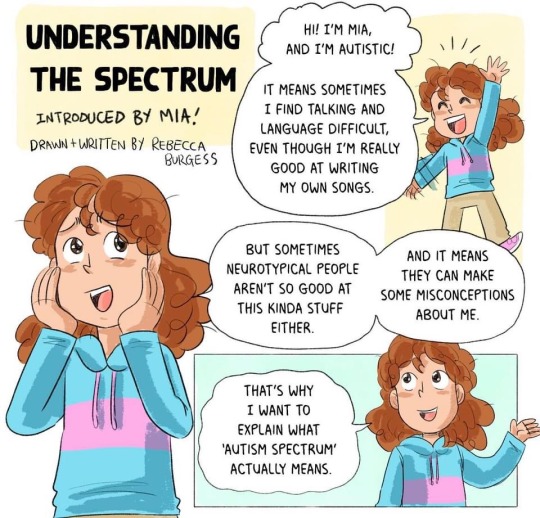

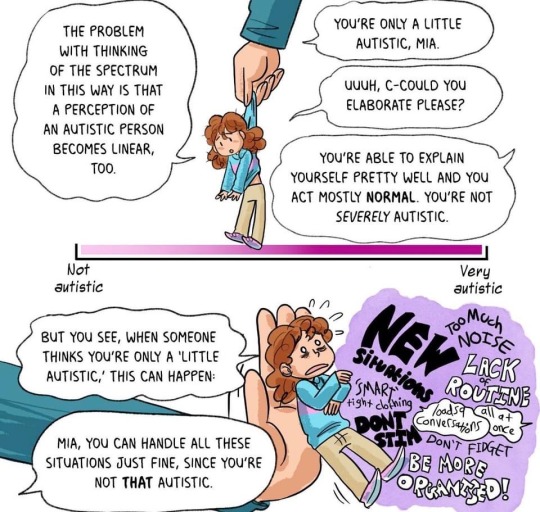
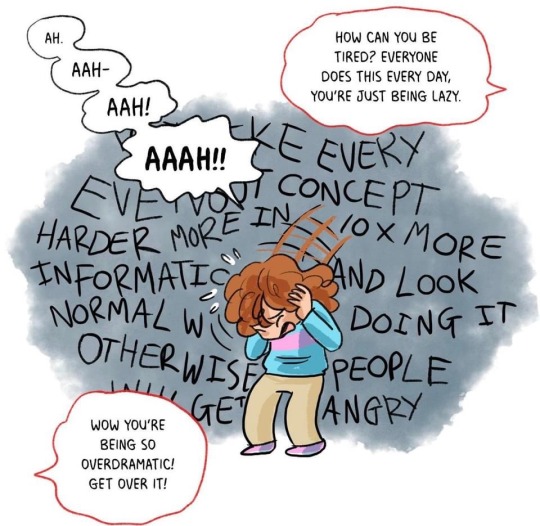
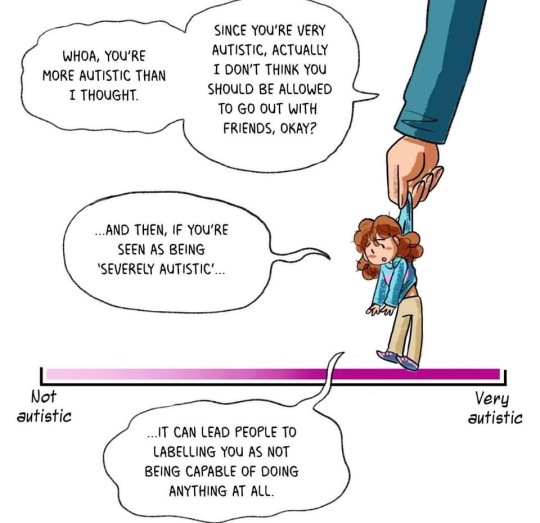
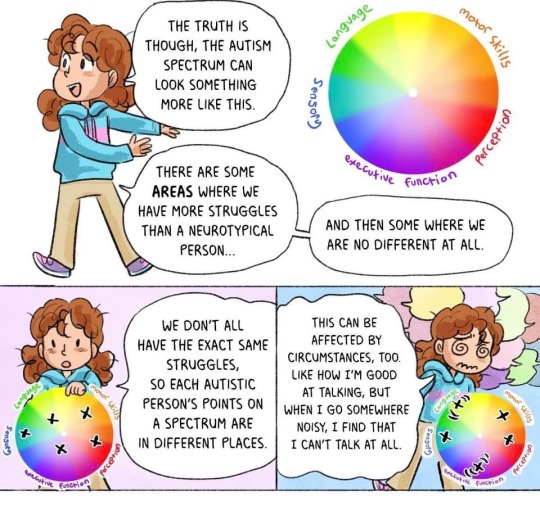
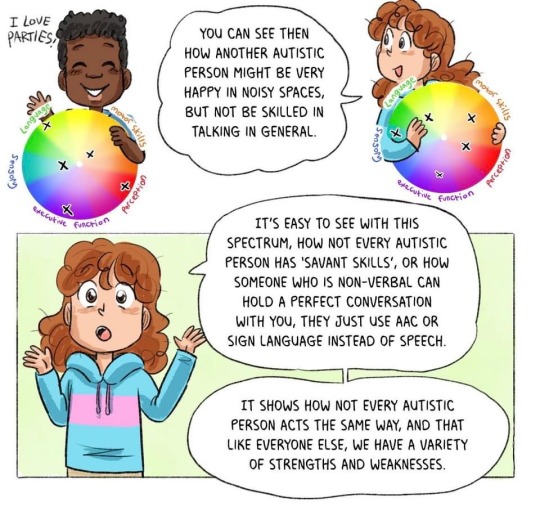
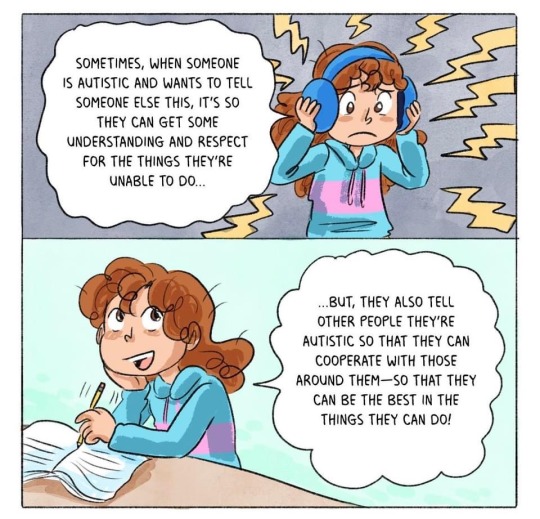
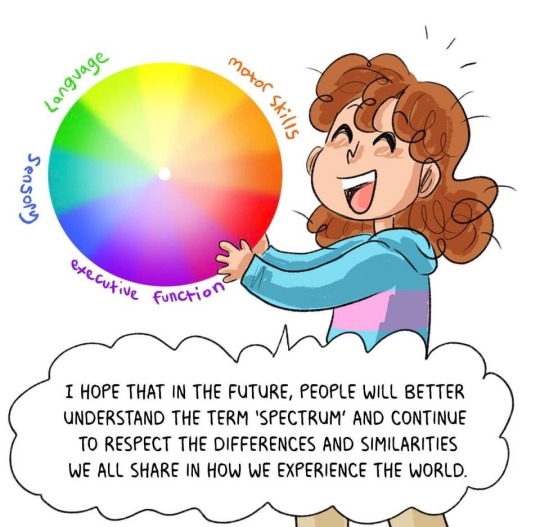
I CAN Network Ltd
#autism#autism awareness month#autism acceptance month#understanding the spectrum (updated)#informative#educational#actually autistic#neurodivergence#neurodiversity#actually neurodivergent#feel free to share/reblog#I CAN Network Ltd (Facebook)
334 notes
·
View notes
Text
the self-concept

hellour! this is gonna be a long post!
.・。.・゜✭・.・✫・゜・。.
i was studying for my social psychology course today (for context i'm a psych major) and read something that might be helpful for everyone who's been having doubts about manifestation subconsciously being part of our everyday lives—as opposed to something made up by the internet.
the information i'm about to provide is from actual sociologists and psychologists, so this is rooted in studies. i promise i'm not about to pull info out of my ass! this is mainly just a very very brief summary of the self concept chapter we're reading about in class.
side note, i named all the researchers in case you wanna check out their work yourself! i made this post to provide insight about our self-concept and clear limiting beliefs. :)
what is self-concept?
so we hear the term self-concept a lot in the manifestation community. Neville, Edward, Sammy, Dr Joe Dispenza, bloggers on tumblr… all of them talk about it all the time. but what does it actually mean?
the self-concept refers to the total sum of beliefs that people have about themselves. it consists of cognitive molecules that social psychologist Hazel Markus called self-schemas. these are the beliefs about ourselves that guide the processing of self relevant information. but what does this actually mean?
well, self-schemas are to the self-concept what books are to a library. if someone asks about yourself, you will probably answer with something quick like: “i am a woman” or “i am a student.” those simple attributes are part of your self-schema; if we want to go deeper, body weight is also a self-schema. for people who regard weight as a crucial part of their beliefs, something simple like a gym trip with friends or buying stuff at the supermarket may trigger thoughts about the self. but if a person is aschematic (not concerned by a certain attribute) about body weight, no thoughts will pop up.
we already know that the self is a special object of our attention. whether its a thought or a song, our consciousness is like a spotlight. this means that it can shine on one object at one point in time, yet shift rapidly from one object to another and process information outside of awareness. in this spotlight, the self is at the forefront of our minds. its what's most important to us at that moment. keep this in mind for later!
to finish with the explanations, neurologist Oliver Sacks highlighted two important points about the self:
🩷 there is a private “inner” self, and an “outer” self we show to others. if we don’t self reflect to understand how were feeling, how will we understand our emotions and actions?
🩷 the self is heavily influenced by social factors.
now–what does that last point mean? well, what we think about ourselves is rooted from childhood. if we grow up hearing “you’ll never amount to anything” or “you’re my favorite child” (extreme examples i know), then that's what we’ll ingrain in our self-concept. this notion brings me to the fun stuff–the studies!
is self-concept scientifically proven?
psychologist Gordon Gallup performed a series of studies where he put animals in front of a mirror to test if they could recognize themselves. at first, they vocalized and greeted themselves in the mirror (my dog did this too when he was a pup, he would bark at his own reflection and play with it), but after several days, only great apes seemed capable of self recognition, using the mirror just like any other human would. grooming themselves, making faces… in short, they recognized themselves!
why do i bring this experiment up? well, this proves that the concept of “me” is necessary to define our self-concept. we must first recognize ourselves as Something to become Someone.
using that same study in humans, this process of self-recognition begins between 18-24 months. which means that from this point onwards we start to define Self (consciousness).
you might read this and–admittedly–think: “oh this blog post hasn’t said anything about manifestation!” true, but i want to present the basics or self-concept first to understand how it affects our daily thoughts!
there was another experiment we talked about in one of my lectures (i do not remember who performed this study specifically, but Dr Patrick Heck did one similar to this one and the results were the same), where participants were told to take a test. half of them were told to boast about themselves, and the rest were instructed to describe themselves modestly. naturally, participants who spoke highly of themselves scored higher on these tests than participants who didn’t. so… you all see where i’m going with this.
remember how i said to keep the “consciousness is a spotlight” paragraph in mind? i’ll finally touch on it with this next and last thing i’m gonna talk about (in this post at least!).
we already established that the first step in the evolution of our self-concept is the ability to recognize ourselves as Someone. the second step, however, involves social factors. sociologist Charles Horton Cooley introduced the term looking-glass self to suggest that other people serve as a mirror in which we see ourselves. and another sociologist by the name of George Herbert added that the only way to know ourselves is by imagining the opinions of our significant others and applying them to our self-concepts. sounds familiar?
how do i change my self-concept?
Neville mentioned the “mirror-self” on his conferences too. he said that one of his favorite techniques to better his Self was to imagine a loved one speaking kindly of himself. in his book Your Faith is Your Fortune, Neville wrote: “Stop trying to change the world since it is only the mirror. Man’s attempt to change the world by force is as fruitless as breaking a mirror in the hope of changing his face. Leave the mirror and change your face. Leave the world alone and change your conceptions of yourself. The reflection then will be satisfactory.”
since the self-concept is a library (our perception of Self) made out of self-schemas (books brought to us by our peers), we can see that sometimes, what we think of ourselves is just an amalgamation of beliefs implanted to us by the people in our lives. so if we were given these books we don’t like, why should we keep them in our library?
to change these negative beliefs we have about ourselves, all we have to do is replace them with positive ones. i know, i know, this is what every person who studies loa and manifestation regurgitates over and over. its nothing that hasn’t been posted to numerous blogs or twitter threads before.
however, the point about this whole post is to tell you why that is the only way to change your self-concept. if your daily thoughts are filled with phrases like: “my sp doesn’t want me” and “i’m so broke” or “what’s the point? this is all worthless anyways.” STOP. DROP. CHANGE.
journal. write your limiting beliefs in your ipad, paper, wood, stone–whatever.
use your hands to apply muscle memory. once you have them, CROSS THEM OUT!
i can’t manifest = I CAN MANIFEST EVERYTHING I WANT
i hope i shift tonight = I KNOW I SHIFT EVERY NIGHT
i wish i had money = I HAVE ALL THE MONEY I WANT AND MORE
just those small changes are enough to rewire your entire self-concept. also, exposure. the more exposure you have to something, the more insecure it will make you. if you’re having a hard time manifesting, remove all blogs, twitter accounts, and people that limit your beliefs. less exposure to negativity = less negativity reflected in your self-concept.
problems with the Self will always be there. if you remove a negative belief, another will pop up. all you can do is learn more about your “inner” self and recognize how you’re feeling. what you can do is focus on the positives, and automatically, your self-concept will change.
persist in the assumption until it becomes your reality!


.・。.・゜✭・.・✫・゜・。.
thank you all for making it this far! just in case, the book i got this information from is Social Psychology 11th Edition authored by Kassin, Fein and, H.R. Markus. there’s a lot of interesting information on this academic book that is similar to the ones Dr Joe Dispenza has written, so i could make another post like this in the future! take care!
#loa tumblr#law of assumption#loassumption#self concept#informative#social psychology#neville goddard#reality shifting#psychology#shiftblr#reya singh#shifting#edward art#quantum jumping#void state#research
250 notes
·
View notes
Text

The Tallest Trees in the World
#infographic#chart#nature#science#trees#educational#informative#today i learned#learning#biology#botany#plants#interesting#fascinating
442 notes
·
View notes
Text
Wet Beast Wednesday: moray eels
This week on Wet Beast Wednesday I'll be going over something amazing, a fish with a sense of morality. You see, the moral eel is known for, what... I think I'm reading this wrong. Oh, MoRAY eel, not moral. Well this is awkward. Hang tight, I need to go redo my research.

(Image: a green moray (Gymnothorax funebris) swimming outside of its burry, with its whole body visible from the side. It is a long, slender fish that looks a bit like a snake. A long fin starts just below the head and continues down the length of the body. The body is arranged in a wave pattern. It has a pointed snout and small eyes. Its body is a yellow-green color. In the background is the sandy seafloor, dotted with various sponges and corals. End ID)
Moray eels are true eels, meaning they are in the order Anguiliformes. Yeah, I did wolf eels, electric eels, and lamprey eels before I got around to actual eels. There are over 200 known species of moray eel in 15 genera. Like other eels, they are elongated bony fish with extra vertebrae and reduced fins. Moray eels have fewer fins than most eel species, only having a dorsal, anal and tail fin that merge together and run down the back of most of the body and underneath portion of it. They achieve motion by undulating this long fin and sometimes undulating the rest of the body as well. Moray eels aren't the fastest of fish, but they can swim backwards, something almost no fish can. The head has a long snout with wide jaws. Most species have long fangs used to grab onto prey, but a few species are adapted to eat hard-shelled prey and have molar-like teeth to crush through shells instead. Probably the coolest feature of morays are the pharyngeal jaws. This is a second set of jaws located in the back of the mouth. When the eel bites onto prey, the jaws can be shot forward to grab the food and help pull it into the throat. While lots of fish have pharyngeal jaws, morays are the only ones who can extend their pharyngeal jaws forward and use them to grab prey. Morays have smooth, scaleless skin that is often patterned to provide camouflage. The skin is coated in mucus that provides protection from damage and infection. In some species, the mucus can be used to glue sand together to help reinforce burrows. Morays lack lateral lines, a system of organs found in most fish that senses changes in water movement. Their sense of smell is their primary sense. The size of morays varies between species. The smallest species is the dwarf moray eel (Gymnothorax melatremus) which reaches 26 cm (10 in) long. The largest species by mass is the giant moray eel (Gymnothorax javanicus) which can reach 3 meters (10 ft) and 30 kg (66 lbs) while the longest species is the slender giant moray (Strophidon sathete), the longest known specimen of which measured in at 3.94 m (12.9 ft).

New reaction image
(Image: a giant moray (Gymnothorax javanicus) emerging from a burrow. It is brown and mottled with yellowish patches. Its head is pointed at the camera and it's mouth is wide open, aming it look shocked. End ID)

(Image: an anatomical diagram of the skeleton of a moray eel emphasizing the pharyngeal jaws and the muscle attachments. End ID. Art by Zina Deretsky)
Moray eels are found throughout the Atlantic, Pacific, and Indian oceans. Different species are found in different temperatures and depths, though most species live in relatively shallow, warm water. Several species can live in brackish water and a few will swim upriver and live for a time in fresh water, though there do not appear to be any species that live their entire lives in fresh water. Morays are ambush predators who rely on the element of surprise. They live in small, tight places such as holes in coral, gaps between rocks, or sandy burrows. When prey passes, the eel can lunge out and grab it. Unlike most fish, the eel cannot use suction feeding due to the shapes of their mouths. They have to rely on lunging froward and catching prey with their mouths. Their mouths are adapted in shape to push water to the sides. This reduces water resistance and avoids creating a wave that could push prey away from the eel. If an eel catches prey that cannot be swallowed whole, it will tie itself in a knot while biting on to the food. By pulling its head through the loop, the eel can rip the food into bite-sized pieces. Spending most of their times in burrows also provides protection from predators, especially in juveniles or smaller species. At night, the eels will come out of their burrows to hunt sleeping prey while the larger predators are asleep. Giant morays have also been seen engaging in interspecies cooperative hunting with roving coral groupers (Plectropomus pessuliferus). The eels can fit into small crevices the groupers can't to flush prey into the grouper's path while catching their own. Morays are mostly solitary species and many can be territorial. They are known to be shy and will retreat into their burrows if they feel threatened. They are also curious and many species are quite intelligent.
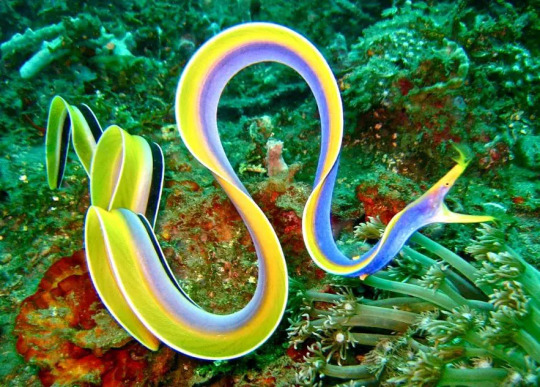
(Image: a male ribbon eel (Rhinomuraena quaesita) on a coral reef. It is a very long and slender eel with its body curved in many waves. It is brightly colored, with a blue-purple body, yellow fin and face, and a long black and white stripe running down the back half of the body. On the nostrils are two feather-like structures. End ID)
Morays reproductive strategies are poorly known and differ based on species. While many species seem to have no set mating season and will reproduce whenever they can, others will mate at the same time every year. Some species seem to have dedicated spots to lay their eggs and a few are believed to be anadromous, meaning they travel from the sea to fresh water to spawn. Meanwhile, some of the species that spend a lot of time in fresh water are catadromous, meaning they return to sea to mate. Females will lay their eggs and the male fertilize them. After this, they depart, providing no parental care. As with all true eels, moray eels begin life as leptocephalus larvae. This type of fish larvae is notable for its resemblance to a simple, transparent leaf with a head on one end. These larvae are unique and poorly understood, despite being the larval stage of a lot of different species of fish. They are unusually well developed for larvae, capable of active swimming and generally living life. In fact, some particularly large leptocephalus larvae were initially mistaken for adult fish. They feed mostly on bits of drifting organic material called marine snow and can remain in the larval stage for up to 3 years, with those in colder conditions usually taking longer to metamorphose. All leptocephalus larvae start out with no sex organs, then develop female organs, then develop male ones, becoming simultaneous hermaphrodites. They will ultimately become eith male or female and it is likely that environmental factors are the main determining factor. During metamorphosis into a juvenile, the leptocephalus can reduce in size by up to 90%, resulting in the juvenile being smaller than the larva. The process of maturation is poorly understood, but it seems that most morays will be sexually mature by three years of age.

(Image: multiple photos of a particularly large leptocephalus larva (not sure what species). It is a translucent organis, wth a body shaped like a very long leaf, narrow at both ends. In the frint is a very tiny head. End ID)
Morays are shy and generally avoid humans. Though some cultures have hunted them for food, they are often not considered a particularly good food source. Many species have high levels of chemicals called ciguatoxins in their bodies, which can lead to a condition called ciguatera fish poisoning if eaten. The largest threat to morays is habitat loss. This is especially true for the many species that live in coral reefs, which are in increasing danger due to global warming. Attacks on humans are rare and usually happen as a response to a human sticking their hand in the eel's burrow. Some of the large species could cause significant damage with a bite. Some species, usually the smaller ones, are found in the aquarium trade, thought they are not good pets for beginners as even the smallest morays are still large for aquarium fish and have some specific requirements. The curiosity many morays have has led to some becoming familiar with and even friendly to humans, often the result of feeding them. They can recognize individual humans and remember them over the course of years. Aquarium employees sometimes report that the eels will come to nuzzle and play with them and have personalities like dogs. Marine biologists and professional SCUBA divers Ron and Valorie Taylor befriended a pair of eels they named Harry and Fang at the Great Barrier Reef who would remember them and come out to visit them year after year.
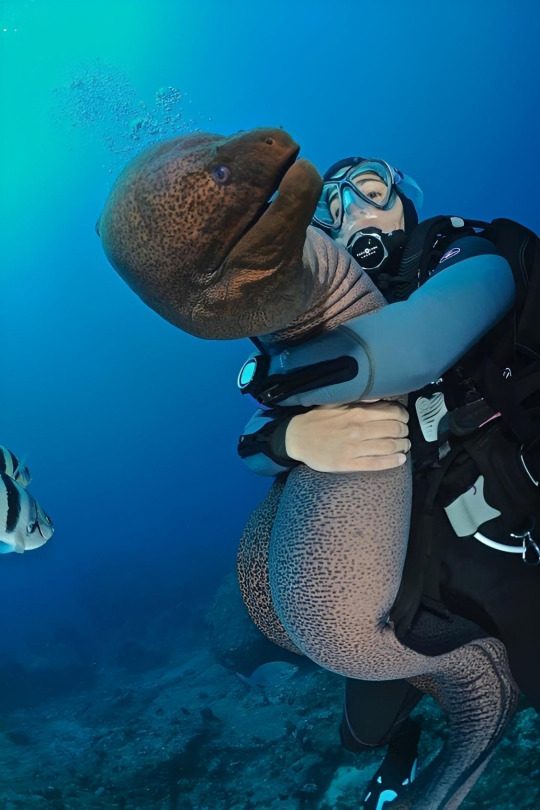
(Image: a SCUBA diver hugging a large, brown moray with black spots. End ID)
youtube
(Video: A shot video showing Valeria Taylor and a moray eel she befriended)
youtube
(Video: the song "That's a Moray", a parody of the song "That's Amore" by Dean Martin)
#wet beast wednesday#i accidentally typed moron eel more than once#moray eel#eel#anguiliformes#fish#bony fish#fishblr#fishposting#eelposting#marine biology#biology#ecology#zoology#animal facts#informative#image described#that's a moray#educational#Youtube
685 notes
·
View notes
Text
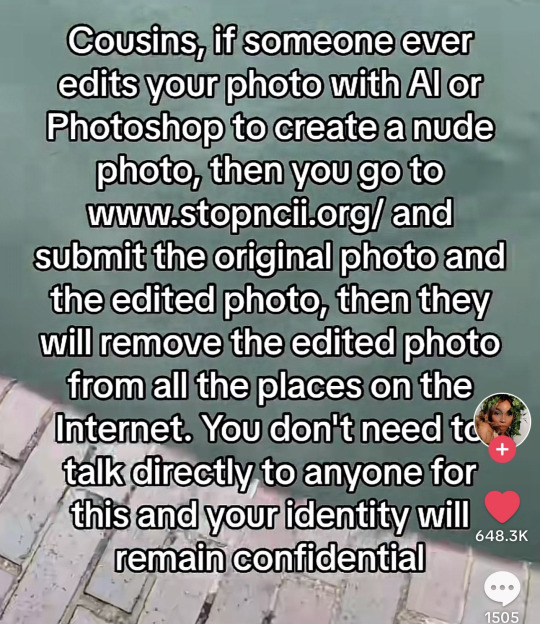
"Stopncii.org is a free tool designed to support victims of Non-Consensual Intimate Image (NCII) abuse."
"Revenge Porn Helpline is a UK service supporting adults (aged 18+) who are experiencing intimate image abuse, also known as, revenge porn."
"Take It Down (ncmec.org) is for people who have images or videos of themselves nude, partially nude, or in sexually explicit situations taken when they were under the age of 18 that they believe have been or will be shared online."
#important information#image desc in alt text#informative#stop ai#anti ai#safety#internet safety#exploitation#tell your friends#stay informed#the internet#internet privacy#online safety#stay safe#important#openai#tiktok screenshots#tiktok#life tips#ysk#you should know#described#alt text#alt text provided#alt text added#alt text in image#alt text described#alt text included#id in alt text
461 notes
·
View notes
Text
Masterpost of informational posts
All posts are written for everyone, including those with no prior computer science education. If you know how to write an email and have used a computer at least sparingly, you are qualified for understanding these posts. :)
What is a DDoS
What are the types of malware
Vulnerabilities and Exploits (old and somewhat outdated)
Example of how malware can enter your computer
What are botnets and sinkholes
How does passwords work
Guide for getting a safer password
Here are various malware-related posts you may find interesting:
Stuxnet
The North Korean bank heist
5 vintage famous malware
Trickbot the Trickster malware (old and not up to date)
jRAT the spy and controller (old and not up to date)
Evil malware
New to Linux? Here's a quick guide for using the terminal:
Part 1: Introduction
Part 2: Commands
Part 3: Flags
Part 4: Shortcuts
If you have any questions, request for a topic I should write about, or if there is something in these posts that you don't understand, please send me a message/ask and I'll try my best to help you. :)
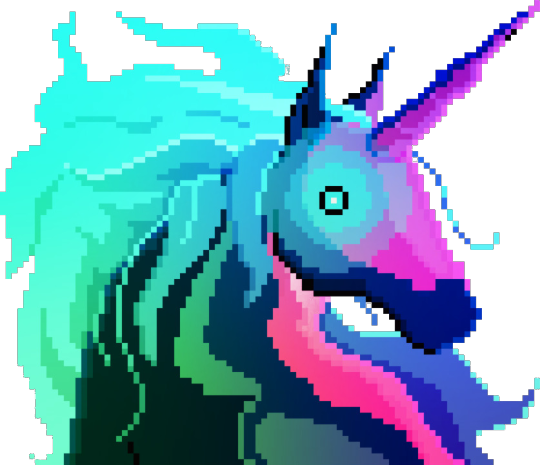
- unichrome
Bonus: RGB terminal
#datatag#masterpost#malware#cybersecurity#infosec#security#hacking#linux#information#informative#computer science
199 notes
·
View notes
Text
Triggers : Random Hornyposting/Peen Talk [Mature +18 Minors DNI]
💚Let's talk about peens... 🥒
Is it spotted,twisted with clasps that hold your holes open? Idk,is it like a drill bit that vibrates?What if it has huge throbbing veins on it that naturally pump once they start getting in those guts? 😵💫
Does it bloom like a flower when they're hard and then the stripped peen reveals?Do little tongue thingies come out of the pee hole to tickle and touch more sensitive parts or penetrate and open up your other hole with some crazy aphrodisiac that makes you all fuzzy and super sensitive to touch😏 [Throwing Beleth under the bus]
Does it split or something and just goes all insane while they're thrusting,with fine keratin hairs decorating it to tickle their lover once they get in? Do they stick in those areas and pulse tickles through you? 🥴
Because when you think monster,you think otherworldly. Their stuff shouldn't be generic. It's good to always give the reader a gloss of what they're going to get from that said monster.
[Plants and other creatures/bugs/aliens/slimes are my faves to write about. Their peens don't have a default option or default size! Or my Katten species! Their tails double as peens! So you get three🙃]
The fandom is mostly wolves,vamps and orcs. Some writers get really creative with their packers..which I really can't do😳Spectacular reads I tell you..🥵💚

TYSM for reading 💚
131 notes
·
View notes
Text


Sea Angels ⋆.ೃ࿔*:・
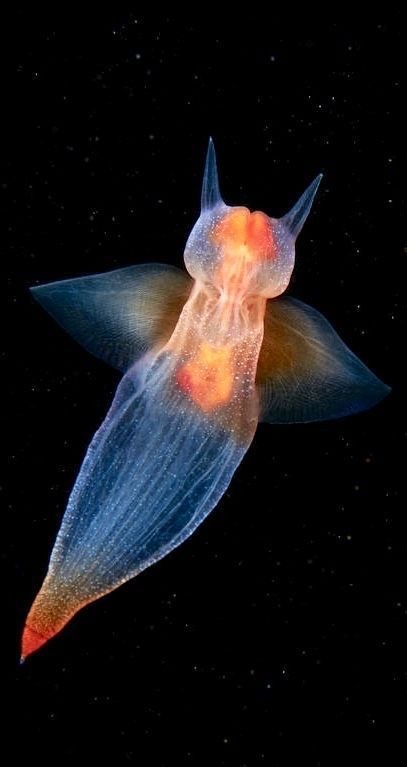
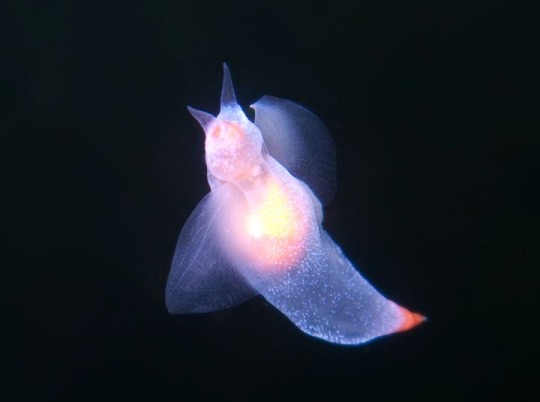

Sea angels are a type of free-swimming sea slugs! They normally grow up to only 5 centimeters long, which is only a little bit less than 2 inches. They eat other free-swimming sea slugs, such as the sea butterfly. They normally live for up to 2 years. Sea angels are also able to switch between sexes. In their life, they are born male and turn female! mtf icons >_< !

#not my photos#sea angel#sea slug#sea slugs#sea angels#sea critters#sea creatures#sea life#ocean#ocean life#ocean creatures#ocean critters#blue aesthetic#marine#marine life#marine biology#silly guys#info#informative#water#creatures#critters#marine animals#animals#sea animals#sea animal#ocean animals#ocean animal#🫧#sprklngstrs
522 notes
·
View notes
Text
The way you ask for reassurance matters.
There are ways that people ask for reassurance that I think aren’t efficient for either person involved.
For example, hinting for reassurance tends to cause issues for both parties. (For example: “I really wish people would show me they love me.) The person hinting may take the person not catching the hint as "proof” they don’t care. Hinting assumes that everyone is able to pick up on things the same way, and that’s not the case. It’s also possible that someone may notice the hinting and it may put them on the defense for many reasons. For me personally, I dealt with some people that would hint at things and then get angry at me when I didn’t understand. It’s made me feel nervous whenever someone hints for something from me.
Another example is “asking” for reassurance by insulting yourself to someone. (This could fall under hinting as well). Saying things like “I’m worthless. No one loves me.” can also put people on the defense. It can also make people feel unsure about what to do and stressed. It may be overwhelming and can make it hard to respond to. It can lead to people feeling hurt because they do love you and they feel accused. This approach may also make people feel they are being manipulated, even if that is not the intent of the person trying to get reassurance. This can be draining and I think is more likely to make someone burn out and be reluctant to engage in the future.
I speak for myself about asking for reassurance, I am sure there are other ways it can be done in a way that works for people.
The first thing I tend to do is try and self-soothe and target the issue myself. If I am feeling like I need reassurance, I will look through my “screenshots” folder, which is a folder I have of screenshots of people I care about saying things that make me feel good. Like that they care about me, or good things about me. I also keep a note of things loved ones have done for me that have made me feel loved, without verbally saying it.
I also work at challenging my thoughts with evidence.
Sometimes, it works and I am able to resolve it by myself. But there are times it doesn’t, and that’s really fair. In that case, I will ask for reassurance.
How I ask differs slightly from person to person, but usually I will make sure to word it something like this: “This is not a reflection of you at all, but I’m feeling insecure (or whatever feeling it is), would you mind giving me some reassurance? (And if possible, I specify the reassurance needed, like "that you aren’t mad at me.”) I like to assure people it’s not about them because one of the issues people run into in asking for reassurance is the person needing to give it feels like they are doing something wrong.
I have one friend where she knows more and we can be more casual and I tend to word things like “My BPD is being really rude right now. I know it’s not true, but it’s hard to feel it. Can you reassure me that you care about me?”
TLDR: Try and be straight forward in asking for reassurance, and don’t hint around at trying to get it as people aren’t mind readers and may miss it or they might feel defensive and like they’re being manipulated even if that is not your intention.
124 notes
·
View notes